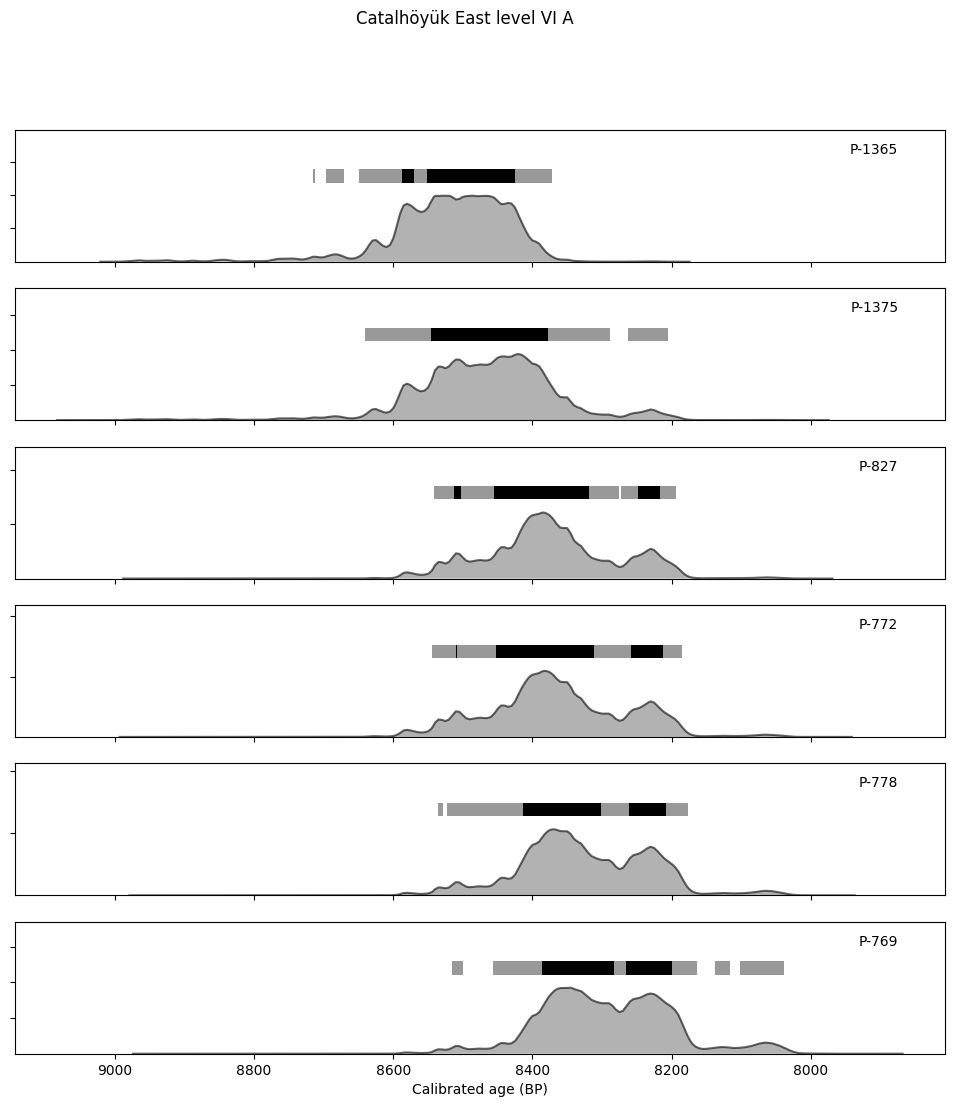Loading radiocarbon dates from a spreadsheet or CSV file#
This tutorial is useful if you have a spreadsheet or CSV file with radiocarbon dates that you want to load, calibrate and plot with IOSACal.
It’s assumed that you have followed the steps in Installation.
The first step is to import the building block of IOSACal, the R command (it’s a short version of the full RadiocarbonDetermination name of the command).
from iosacal import R
Let’s imagine you have six dates you want to calibrate and plot together. In plain Python, you can create a tuple or a list containing six R items, like this:
catalöyük_east_level_vi_a = (
R(date=7729, sigma=80, id="P-1365"),
R(date=7661, sigma=99, id="P-1375"),
R(date=7579, sigma=86, id="P-827"),
R(date=7572, sigma=92, id="P-772"),
R(date=7538, sigma=89, id="P-778"),
R(date=7505, sigma=93, id="P-769")
)
Obviously, entering data like this in a Jupyter notebook can get quickly tedious and error prone. We’re in a programming environment, so let’s take advantage of that.
If the six dates are saved in a CSV file, they can be loaded with the csv.DictReader command from the Python standard library.
For convenience, in this tutorial the CSV file has three columns (fields) named date, sigma and id, exactly as the parameters of the R function. This is not necessary, however, and the CSV file can have more columns, or have different names.
Each date is loaded in a row item and we can print it as we iterate through all the data from the CSV file.
from csv import DictReader
with open("dates.csv") as dates:
dr = DictReader(dates)
for row in dr:
print(row)
{'date': '7729', 'sigma': '80', 'id': 'P-1365'}
{'date': '7661', 'sigma': '99', 'id': 'P-1375'}
{'date': '7579', 'sigma': '86', 'id': 'P-827'}
{'date': '7572', 'sigma': '92', 'id': 'P-772'}
{'date': '7538', 'sigma': '89', 'id': 'P-778'}
{'date': '7505', 'sigma': '93', 'id': 'P-769'}
We can build on this by calling the R command on each row.
Please note that you need to explicitly tell Python that the date and sigma fields are numeric integer values with the int() function.
with open("dates.csv") as dates:
dr = DictReader(dates)
for row in dr:
uncal = R(
int(row["date"]),
int(row["sigma"]),
row["id"]
)
print(uncal)
RadiocarbonSample( P-1365 : 7729 ± 80 )
RadiocarbonSample( P-1375 : 7661 ± 99 )
RadiocarbonSample( P-827 : 7579 ± 86 )
RadiocarbonSample( P-772 : 7572 ± 92 )
RadiocarbonSample( P-778 : 7538 ± 89 )
RadiocarbonSample( P-769 : 7505 ± 93 )
Neat! IOSACal was able to load each radiocarbon determination.
Now it’s time to put all dates together as we manually did at the beginning of the tutorial. There are several ways to create a list of items in Python, this is not the most “pythonic” but it’s more clear:
calibrated_dates = [] # an empty list
with open("dates.csv") as dates:
dr = DictReader(dates)
for row in dr:
uncal = R(
int(row["date"]),
int(row["sigma"]),
row["id"]
)
cal = uncal.calibrate("intcal20")
calibrated_dates.append(cal)
If we look at the calibrated_dates list, it contains six CalAge items, each item is the calibrated date corresponding to the uncalibrated date from the CSV file.
calibrated_dates
[CalAge([[9.02100000e+03, 3.92784281e-08],
[9.02000000e+03, 4.85191138e-08],
[9.01900000e+03, 5.64501812e-08],
...,
[8.17600000e+03, 1.14218050e-07],
[8.17500000e+03, 8.72043365e-08],
[8.17400000e+03, 6.80115020e-08]]),
CalAge([[9.08300000e+03, 3.22843034e-08],
[9.08200000e+03, 3.69285830e-08],
[9.08100000e+03, 4.22125083e-08],
...,
[7.97600000e+03, 4.44023873e-08],
[7.97500000e+03, 4.00083797e-08],
[7.97400000e+03, 3.49544048e-08]]),
CalAge([[8.98800000e+03, 4.79124169e-08],
[8.98700000e+03, 5.75837259e-08],
[8.98600000e+03, 6.91284814e-08],
...,
[7.97100000e+03, 8.64508537e-08],
[7.97000000e+03, 7.44674428e-08],
[7.96900000e+03, 6.41687660e-08]]),
CalAge([[8.99300000e+03, 3.94036941e-08],
[8.99200000e+03, 5.20032974e-08],
[8.99100000e+03, 6.83947509e-08],
...,
[7.94300000e+03, 6.12814412e-08],
[7.94200000e+03, 5.59495905e-08],
[7.94100000e+03, 5.10631497e-08]]),
CalAge([[8.97900000e+03, 4.34115677e-08],
[8.97800000e+03, 4.92556399e-08],
[8.97700000e+03, 5.58610049e-08],
...,
[7.93900000e+03, 9.99403504e-08],
[7.93800000e+03, 7.89228624e-08],
[7.93700000e+03, 6.21575157e-08]]),
CalAge([[8.97400000e+03, 3.23557224e-08],
[8.97300000e+03, 3.51279332e-08],
[8.97200000e+03, 3.81332208e-08],
...,
[7.87000000e+03, 6.68068906e-08],
[7.86900000e+03, 5.58865533e-08],
[7.86800000e+03, 4.66849735e-08]])]
Now all dates that we are interested in are calibrated and loaded in a list.
We can plot them together using the iplot command.
from iosacal import iplot
iplot(calibrated_dates, name="Catalhöyük East level VI A")
